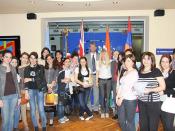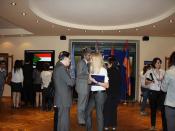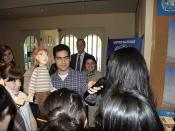Principio del formulario English in the community Look at the three extracts from adult coursebooks in the Assignment section of your printed study materials. Analyse the cultural content of these extracts, drawing on insights you have derived from the study of this subject. Student response Before looking into the three extracts and their impact on cultural content, I would like to introduce my personal perspective on the issue of culture in the EFL curriculum, an issue which has clearly gained its place in the spotlight in foreign language learning. We have seen in the subject "English in the Community" that the term "culture" can adopt an array of meanings depending many times on the academic field which defines it. In our own discipline, ELE (English Language Education), in order to handle this term effectively, it is essential to examine the relationship between language and culture and reflect upon the teaching of culture as an integral ingredient in the English language lesson. So what is culture, or what components of culture are usually addressed in the English language lesson? Commonly, English language educators draw attention to cultures which have English as their mother tongue and address such issues as holidays, clothing, food and concepts of the sort. These notions can be categorized under what Clarke (1996) distinguishes as culture as content. This first category is frequently evidenced in modern text books and comprises an important framework in transmitting cultural knowledge. Nevertheless, a broader context is needed if our goal to language instruction is to empower learners to function effectively across cultures. Therefore, we also need to conceptualize culture under what Clark goes on to categorize as high culture as well as cultural practice or behavior. High culture, also known as "culture with a capital C", includes the artistic production... |
English in the Community
More Linguistics
essays:
Language Sex And Culture
CONTENTS 1. Introduction 2. The interaction of social and biological processes in women's and men's speech 3. Gender specific usage of speech 3.1. Phonetical studies 3.2. Grammatical studies 4. Conclusion 1. Introduction The orientation of looking at language variation as different cultural and ...
Different Definitions Of Language By Linguists
INTRODUCTION Many linguists agree that there is no all-encompassing definition of Language. However, language is generally described as a system of sounds used to link sound using words and sentences to meaning (Finegan & Besnier 1989, p. 1). Language can be described as a symbolic system in which ...
Listening & Reading: two tasks used in teaching to develop discourse skills in the classroom.
... and McCarthy, M. TESOL Quarterly. Spring 1998, Vol. 32, No. 2. From Sentence to Discourse: Discourse Grammar and English Language Teaching. Levinson, S. C. (1983). Pragmatics. Cambridge: Cambridge University Press. Long, M. and Richards, J. (1987). Methodology in TESOL: A Book ...
ENGLISH FIRST
... language and maintaining the ethnic culture of the family than with teaching children English. The bilingual students would end up in the bilingual program well into high school and costing the California taxpayers more money. This approach kept the students from progressing in English and ...
The ways in which the reading skills can be taught in a communicative classroom
... English as a Second Language (ESL) are disadvantaged because of their insufficient knowledge of the English language does not enable them to understand the meanings. Other readers seem to lack adequate processing strategies rather than knowledge of English. Reading is sometimes referred to as a ...
Language Situation in Mauritius
... and four islands. ENGLISH LANGUAGE IN MAURITIUS English is the official language of Mauritius. It is used in parliamentary and judiciary system and for administrative purposes. English is the medium of instruction at primary, secondary and tertiary level. Though English is the national language ...
In the Face of Poverty
... English language learners, it seems that they do not understand a word that I am saying. This makes it that much more difficult to handle difficult situations and also try to teach the language while teaching mathematical concepts in a ...


